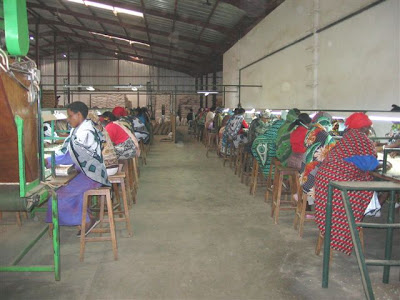 Our farm is historically a bean growing farm, with all the beans we grow being exported to Holland. We only grow beans for seed, and it is this bean seed which is exported. (I wrote about our bean crop in more detail last year, you can read that post over here.)
Our farm is historically a bean growing farm, with all the beans we grow being exported to Holland. We only grow beans for seed, and it is this bean seed which is exported. (I wrote about our bean crop in more detail last year, you can read that post over here.)As I've already covered aspects of our bean crop as it is planted/growing/harvested on our farm in the post mentioned above, today I wanted to show you what happens to the beans once they leave our farm and are transported to our head office/factory in the city.
Can you see all the ladies sitting above in their traditional brightly coloured Kitenge cloths ? Well, they are sorting (grading) the beans by hand. They are employed as casual labour each season - the women are known to pay great attention to detail and this job provides income for many families - for some families, this is their only source of income.
 The railway line runs through our head office/factory yard. You can see the rail carriages in the photo above, waiting to be loaded with the bean seed. You can also see some ladies sitting to the right of the rail carriages - they are also sorting and grading the beans (it was a very busy day when I took this photograph, and they'd run out of space inside !) The rail carriages run to the coastal port of Tanga, where the beans are then put on a ship and sent to Holland. Sometimes they are transported to Tanga by road, too.
The railway line runs through our head office/factory yard. You can see the rail carriages in the photo above, waiting to be loaded with the bean seed. You can also see some ladies sitting to the right of the rail carriages - they are also sorting and grading the beans (it was a very busy day when I took this photograph, and they'd run out of space inside !) The rail carriages run to the coastal port of Tanga, where the beans are then put on a ship and sent to Holland. Sometimes they are transported to Tanga by road, too. Once the beans have been graded/sorted, they are packaged into large (100-115 kg) hessian bags and labelled and then stored in the warehouse in tall stacks, ready to be loaded onto the rail carriages that you see in the middle photograph.
Once the beans have been graded/sorted, they are packaged into large (100-115 kg) hessian bags and labelled and then stored in the warehouse in tall stacks, ready to be loaded onto the rail carriages that you see in the middle photograph.Our farm had 700 acres of beans planted this season, and we grew a total of 8 different bean varieties. Our yield this season was around 400 kg's of beans per acre and our biggest crop threat was - I kid you not ! - elephants .... you can read about those naughty crop chomping ellie's over here.
